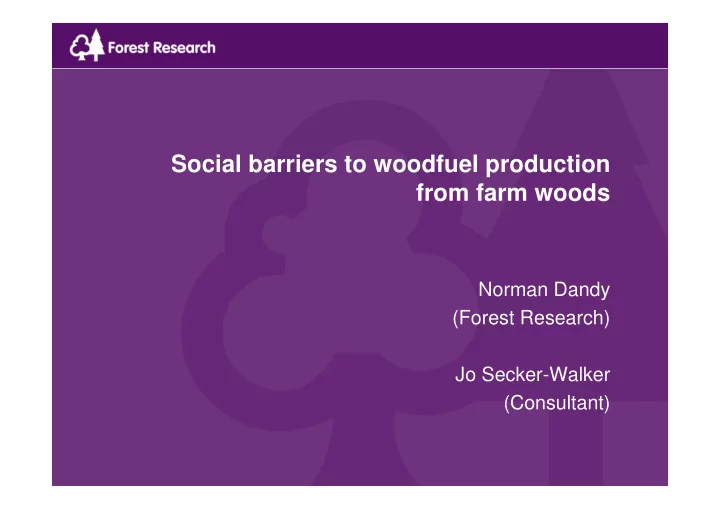

Social barriers to woodfuel production from farm woods Norman Dandy (Forest Research) Jo Secker-Walker (Consultant)
Woodfuel from farm woods Introduction 1. Outline Forest Research Social and Economic Research Group’s woodfuel research programme Identify policy relevance & drivers • Identify some key barriers • 2. Outline primary research project recently conducted in Fife, looking at factors influencing private landowners’ decisions relating to woodfuel production
Woodfuel from farm woods What is ‘woodfuel’? (terminology - barrier #1 !) Title Process Species Product Form Forestry Various Eucalyptus ‘Clean’ wood: Poplar Wood-chips Short rotation forestry (SRF) Ash • Non-timber stemwood (low Pellets Southern Beech diameter; tips; poor quality) Logs others • Branch wood • Stumps Willow Short rotation crop (SRC) Poplar Energy crop Miscanthus High-energy grasses Bales Arboriculture Various Biomass Woody ‘waste’ Wood-chips (‘contaminated’ & ‘clean’) Pellets Commercial & industrial activities - Food ‘waste’ Various Biogas Fuel gas Fuel Solid residue (e.g. straw; poultry Agriculture - litter) Fertiliser Liquid residue (e.g. animal slurry) Oil seed rape Biodiesel Biofuel Agriculture Transport fuel Grains, beets & others Bioethanol
Woodfuel from farm woods Objective: an increasing resource • Each of the devolved Commissions have the objective to increase the woodfuel resource through: • improved and increased woodland management • new planting • Targets not easy to compare as they include various types of material and have differing objectives: • Wales ⇒ 0.692m ODt/y ‘clean wood’ (251MW) – currently 0.183m ODt/y available • England ⇒ 2m GMt/y (c. 1m ODt/y ), 50% of ‘unharvested’ resource (by 2020) • Scotland ⇒ 1m GMt/y (c. 0.5m ODt/y ) (by 2020) – currently 0.41m ODt/y
Woodfuel from farm woods Policy – barrier #2 ?
Energy Security Woodfuel from farm woods SEPA DCLG Woodfuel Policy Delivery Map DECC EA Supply Diversity Efficiency (Local Title Network s) DEFRA Reduced BERR Landfill Kyoto EU RCEP Waste Social Fuel Poverty Justice Alleviation Climate Change CO2/GHG WOOD Renewable Emission Energy FUEL Reductions Targets Rural Economic Devlpt. Local Sustainable Forest Carbon Revenue Storage Capture Management Improved Skills Materials displacement Job Economic Creation DEFRA Development Community Improved Empowerment Biodiversity SNH FC BERR DCLG DIUS DWP Improved Recreational DCLG Value of TWFs NE Nature Sustainable ERAD ELL Conservation Communities
Woodfuel from farm woods Research Focus 1. What influences private landowners decisions regarding woodfuel production? e.g. barrier = lack of landowner engagement 2. What forms of partnerships are appropriate to the establishment of an effective woodfuel sector? (and what is the role of the Forestry Commission?) e.g. barrier = ineffective or contradictory working 3. How do ‘the public’ understand and perceive the use of woodfuel, and woodland management for woodfuel? e.g. barrier = public opposition? 4. What skills are necessary to support an effective woodfuel sector and what changes in employment will there be? e.g. barrier = lack of skilled workforce
Woodfuel from farm woods (Some) Influences upon awareness of resource landowner decisions potential professional economic ‘case’ advice interest in woodland personal values landowner management engagement in woodfuel production bureaucracy & social ‘capital’ communication governmental networks & incentives relationships
Woodfuel from farm woods Methodological challenges • Can woodfuel be treated as a discrete product / issue for social & economic research? • Landowners – who are they and how to categorise? (are farm woods a discrete sector?) • Woodfuel as a system – what to look at? Where do partnerships start and finish? • Understanding relative change – interaction of markets and employment?
Recommend
More recommend